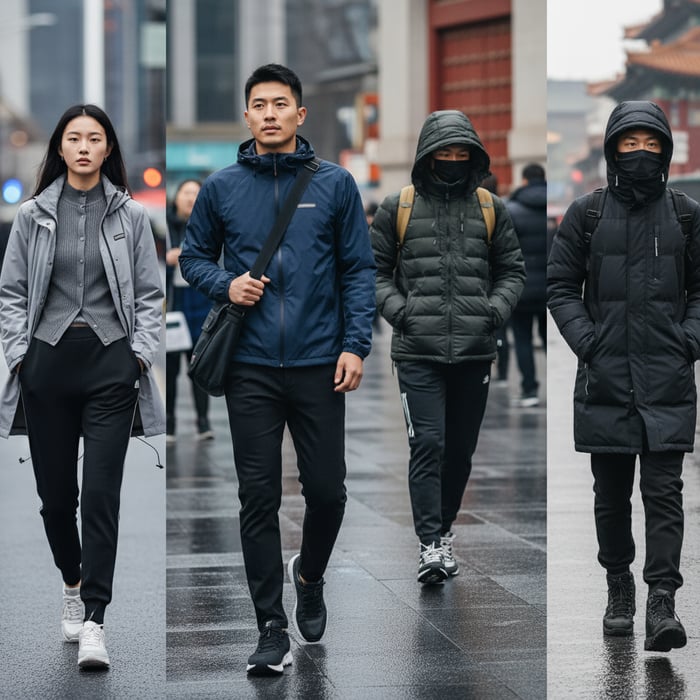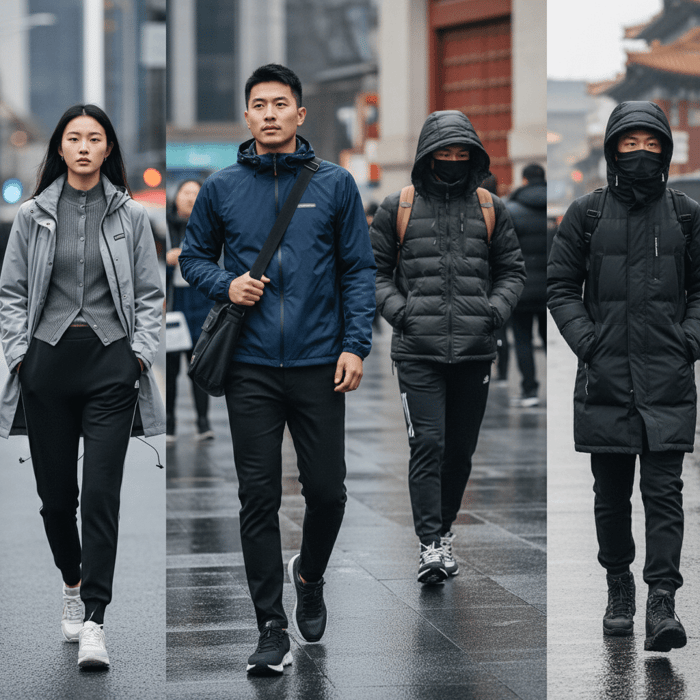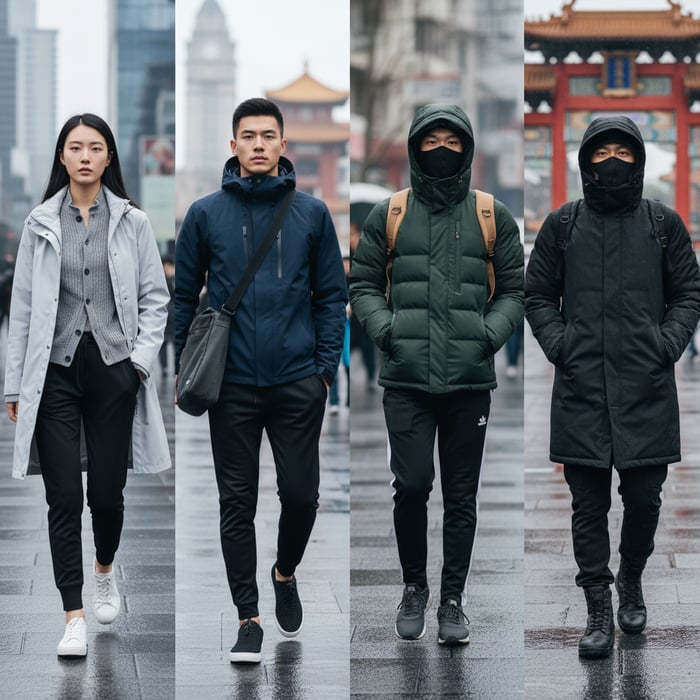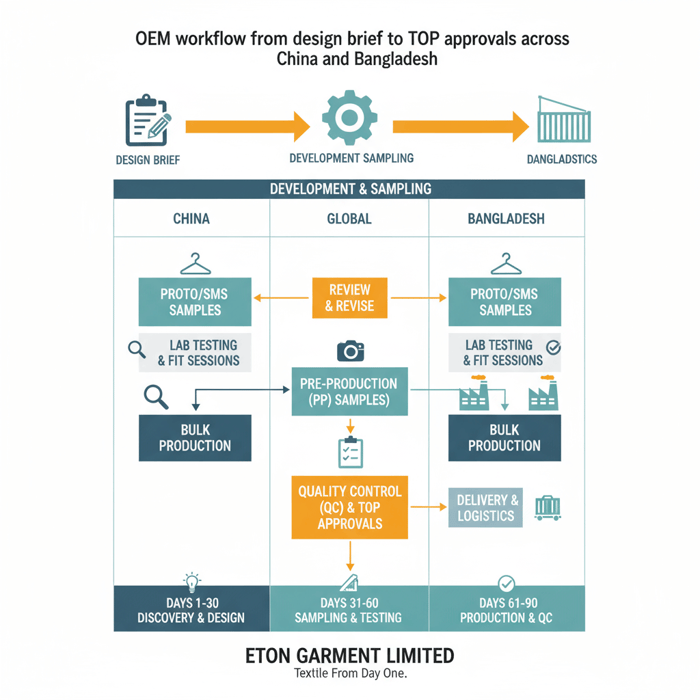What Does Chinese People Wear? Insights for Fashion Brands from a China Clothing Manufacturer

 Mr. Eton Yip | 32+ Year Garment Manufacturing Expert & Founder of Eton Garment
Mr. Eton Yip | 32+ Year Garment Manufacturing Expert & Founder of Eton Garment
October 28th, 2025
17 minute read
What Does Chinese People Wear? Insights for Fashion Brands from a China Clothing Manufacturer
What does Chinese people wear is best understood by separating daily wardrobes from traditional attire and then layering climate, city-tier, and role-based context. As a China Clothing Manufacturer, Eton Garment Limited sees modern China favor casual basics, athleisure, and functional outerwear. Hanfu, Qipao, Tang suits, and Changshan appear at festivals, weddings, and cultural events. Successful assortments match northern and southern climates, reflect platform-driven trends, and meet US/EU compliance. Textile From Day One.
Most people in China wear contemporary clothing similar to US/EU markets: tees, denim, knitwear, athleisure, sneakers, and functional outerwear. Traditional garments—Hanfu, Qipao, Tang suits—are reserved for festivals, weddings, and performances. Style shifts by season and region: heavy insulated jackets in the north; lightweight, rain-ready layers in the south.
What do Chinese people wear today? A modern overview
Daily wear in China is contemporary and practical. The mainstream mix favors casual knits, denim, athleisure, and technical outerwear. Traditional clothing sits in the cultural and formal space. Assortments shift with city-tier, age, and platform trends. Product plans benefit from climate mapping, fabric tech choices, and role-based silhouettes.
In Tier-1 cities like Shanghai, Beijing, Shenzhen, and Guangzhou, daily outfits lean technical and fashion-forward. Lightweight shells, seam-taped parkas, and performance mid-layers are common during shoulder seasons and winter. Commuters pair knit tops with tailored joggers and sneakers. In Tier-2 and Tier-3 cities, the mix adds classic denim, hoodies, and padded coats, with price-value balance a frequent priority. Across the country, sneakers and athleisure sets dominate weekend wear and short trips.
- Tees and knit tops
- Denim jeans and jackets
- Chinos and tailored joggers
- Sneakers and sport-lifestyle footwear
- Hoodies and sweatshirts
- Athleisure sets (leggings, track pants, performance tops)
- Lightweight rainwear and windbreakers
- Insulated jackets (synthetic and down)
- Smart casual jackets and overshirts
- Workwear-inspired pieces (utility pockets, canvas blends)
Eton’s merchandising teams in Xiamen track recurring requests from US/EU brands: urban-ready rainwear with clean lines, light-down packs for travel, and hybrid mid-layers that move from office to weekend. Fit preferences trend toward tailored comfort—not skinny, not oversized. Breathability, water resistance, and thermal performance drive purchase decisions for outerwear.
Hanfu appears daily in niche subcultures and university clubs, yet it remains a minority choice. The mainstream wardrobe mirrors global casualwear with regional climate variation. Platform-driven aesthetics move fast; silhouettes and color stories often propagate on Douyin and then convert on Tmall or Taobao storefronts. [CITE: Contemporary apparel adoption rates with platform influence, 2023–2025] [MENTION: Alibaba Group commerce data; ByteDance platform signals]
Brands considering assortments for China should anchor a four-part plan: map climate zones, inventory daily categories, define role-based looks (office, school, weekend), and set a tech fabric backbone that matches local weather. [INTERNAL LINK: Our outerwear development overview]

Daily vs. Traditional—Core distinction
Daily wear is modern, utilitarian, and comfortable. It focuses on knits, denim, athleisure, and functional outerwear. Traditional attire is cultural and ceremonial. Hanfu, Qipao/Cheongsam, Tang suits, and Changshan hold heritage value and appear at weddings, festivals, and performances. Treat this distinction as a design boundary. Daily apparel uses contemporary fits and fabrics. Traditional garments demand respect for motifs, silhouettes, and matching accessories.
For brands, the distinction shapes choices. Daily wear should lean performance and price-value by city-tier. Traditional-inspired capsules require cultural review, motif accuracy, and careful storytelling. This avoids shallow references that alienate shoppers or misrepresent heritage. [CITE: Cultural garment usage in modern urban China, 2024 study] [MENTION: Jing Daily analysis on Hanfu subculture; Tsinghua research on heritage attire]
Lifestyle drivers: city-tier, age, income
City-tier: Tier-1 shoppers adopt silhouettes sooner and expect higher fabric tech. Tier-2 and Tier-3 buyers watch price-value and durability. Age: Gen Z loves platform-led drops, fun color, and sport-life hybrids. Millennials and Gen X focus on comfort, smart casual looks, and reliable outerwear. Income: premium buyers target high-fill down and Gore-like membranes; value shoppers prefer durable synthetics with clean styling.
Translate these drivers into product decisions. Pick knit weights suited for office AC settings and shoulder seasons. Use stretch wovens for mobility in urban commutes. Add packable rain shells for frequent showers in the south. Offer thermal mid-layers for northern cities with long winters. Match trims and pocket layouts to device carrying habits and public transit routines. [CITE: Segment-based apparel preferences, China urban cohorts] [MENTION: McKinsey State of Fashion data; Statista category revenue snapshots]
Traditional clothing in China: what Chinese people wear for culture and festivals
Traditional garments—Hanfu, Qipao/Cheongsam, Tang suits, and Changshan—carry historical and cultural meaning. They appear at weddings, festivals, formal banquets, and stage performances. They are not mainstream daily wear. Treat motifs, cuts, and accessories with care, and avoid generic prints or misused symbols.
| Garment | Occasion | Key Features | Sensitivity Notes |
|---|---|---|---|
| Hanfu | Festivals, weddings (select), cultural clubs, performances | Cross-collar (jiaoling youren), flowing sleeves, layered robes | Confirm dynasty references; avoid mixing motifs without context; review accessories |
| Qipao/Cheongsam | Weddings, formal dinners, photoshoots | High collar, side slits, fitted silhouette, brocade or silk | Respect body and fit norms; watch slit height; avoid caricatured styling |
| Tang suit | Festivals (e.g., Lunar New Year), formal banquets | Mandarin collar, frog buttons, silk or cotton blends | Check color meanings; avoid misplacing auspicious symbols |
| Changshan | Weddings (groom attire), stage, formal portraits | Long tunic, straight cuts, structured collar | Pair correctly with accessories; align with event etiquette |
Definitions grounded in historical sources help non-local teams keep accuracy. Hanfu references pre-17th century aesthetics with dynasty-specific variations. Qipao/Cheongsam evolved in 20th-century Shanghai with modern tailoring influences. Tang suits and Changshan carry distinct formal cues and fabric expectations. [CITE: Historical overview of Hanfu silhouette families] [CITE: Cheongsam evolution and modern styling] [MENTION: Wikipedia Hanfu page; Wikipedia Cheongsam page]
Modern adaptations appear in fabric blends that improve comfort and maintenance. Lightweight brocades, stretch satins, and wrinkle-resistant weaves make formal garments more wearable. Decorative work shifts toward digital embroidery or laser-cut detailing for consistency at scale. Keep storytelling aligned to heritage and avoid trend-only mashups that dilute meaning. Eton teams have produced occasion-wear elements at OEM scale and recommend a cultural review step during sampling.
Hanfu, Qipao/Cheongsam, Tang suit, Changshan—concise definitions
Hanfu: Traditional clothing of Han Chinese with layered robes, cross-collars, and specific sleeve forms; varies by era. Qipao/Cheongsam: Fitted dress with high collar and side slits, popularized in early 20th-century Shanghai. Tang suit: Jacket with mandarin collar and frog buttons, linked with festival wear. Changshan: Long tunic for men, formal and ceremonial.
These garments carry cultural narratives. Silhouette, accessory pairing, and fabric selection signal respect and knowledge. Reference primary sources for motifs and color meanings. Use local consultants for embroidery placement and proportion checks. [CITE: Color symbolism in Chinese ceremonial attire] [MENTION: Museum of Chinese in America garment archives; Beijing Institute of Fashion Technology research]
Cultural occasions & modern adaptations
Weddings, Lunar New Year gatherings, and stage performances set the highest bar for accuracy. Modern adaptations include easier-care fabrics, concealed zippers for movement, and subtle reinforcements for durability. Photo-driven events draw interest in sheen and rich texture. Keep inscriptions and symbolic graphics in context and avoid casual placement. Eton’s pattern teams suggest prototype reviews with cultural advisors before locking trims and graphics.
What do Chinese people wear by season, region, and role (work, school, weekend)
China’s climate ranges from long, cold northern winters to humid, rainy southern seasons. Northern cities prefer insulated parkas, down jackets, and thermal layers. Southern regions favor lightweight shells, rainwear, and breathable fabrics. Work, school, and weekend roles pull silhouettes from smart casual to athleisure.
| Region | Winter Wear | Summer Wear | Rainwear |
|---|---|---|---|
| North (Beijing, Harbin) | High-fill down parkas, synthetic-insulated jackets, thermal base layers | Breathable tees, light chinos, UV-protective woven shirts | Storm-rated shells; seam-sealed construction for snow and sleet |
| Central (Wuhan, Chengdu) | Mid-weight insulated jackets; fleece mid-layers; windproof shells | Moisture-wicking tops; light joggers; airy overshirts | Water-resistant shells; packable ponchos for summer downpours |
| South (Guangzhou, Shenzhen) | Light insulation; rain-ready shells; breathable knits | Quick-dry tees; shorts; technical polos; sun-protective layers | High-breathability rain shells; venting; DWR finishes |
- Down insulation: Strong warmth-to-weight; compressible; sensitive to moisture without hydrophobic treatments.
- Synthetic insulation: Consistent warmth even when damp; easier care; sometimes bulkier; needs careful quilting to manage cold spots.
Eton QA teams test thermal performance, seam sealing, and breathability with clear targets. Brands should pick ratings matched to local winter lows and infrastructure realities. Commuters in northern cities face ambient temperatures and wind chill. Southern shoppers focus on humidity management and rain protection. [CITE: Climate zone thermal targets for urban apparel] [MENTION: China Meteorological Administration data; retailer tech specs]
Seasonal matrix: fabric, insulation, shell tech
Winter north: Down with hydrophobic treatments or synthetic fills; 2–3 layer shells with taped seams; fleece or knit thermal mid-layers; storm cuffs and thermal hoods. Central: Mid-weight insulation; soft-shells with wind resistance; modular mid-layers; water-resistant zips. South: Lightweight shells with high air exchange; DWR finishes; quick-dry knits; vented back yokes; stowable hoods.
Summer: Moisture-wicking knits; light wovens with stretch; UV-protective fabrics; mesh-lined overshirts; air-permeable panels. Shoulder seasons: Hybrid jackets; packable windbreakers; light down vests; breathable rainwear. Choose zipper garages, chin guards, and lined collars for comfort. Maintain clean seam lines where taping is needed and keep pocket placements functional. [CITE: Comparative breathability measurements for urban shells] [MENTION: Gore-Tex family reference; Toray fabric ecosystems]
Role matrix: office smart casual, uniforms, weekend athleisure
Office smart casual: Knit polos, breathable button-downs, tailored joggers or chinos, lightweight blazers or overshirts. Uniforms (school/work): Polos, track tops, sweatshirts, emblem details; durable knits; easy care. Weekend athleisure: Leggings, track pants, hoodies, performance tees, tech shells. Fit norms skew toward tailored comfort in Tier-1 cities and classic lines in Tier-2/3.
School settings often prefer modest cuts and durable fabrics. Office norms accept smart casual layers and hybrid sneakers. Weekend sets favor soft touch and flexibility. Keep silhouettes consistent with local expectations: modest slit heights and neckline shapes for conservative cohorts; mobility features for transit-heavy commutes. [CITE: Urban dress codes and employer norms] [MENTION: JD.com apparel category reviews; local HR guidance summaries]
How to design for the Chinese market: steps for US/EU fashion brands
A structured plan helps brands move from concepts to market. Validate segments, map climate, localize fits and fabrics, align compliance, and prototype with OEM partners. Use platform insights from Douyin and Tmall to refine silhouettes, color palettes, and trims.
- Discovery: Define personas by city-tier, age, and income.
- Segmentation: Set role-based wardrobe targets (office, school, weekend).
- Climate mapping: Align insulation and shell tech to region-season needs.
- Fabric/fit localization: Choose blends, finishes, and tailored comfort fits.
- Compliance: Plan US/EU labeling and material safety requirements.
- Prototyping: Build tech packs with performance specs; sample fast.
- Line review: Use fit sessions and local feedback loops.
- Pilot: Place limited orders to validate sell-through.
- Scale: Lock QC checkpoints and production schedules.
Methodology notes: Trend signals vary by city-tier. Validate with local partners and recent reports. Keep a living brief that tracks climate targets, silhouette adoption, and platform-driven color shifts. [CITE: City-tier consumer behavior modeling in apparel] [MENTION: McKinsey China chapters; Nielsen retail panels]
Preparation: briefs, metrics, and platform-inspired mood boards
Build briefs with clear persona tags: Tier-1 commuter, Tier-2 office worker, student uniforms. Set climate KPIs: thermal ratings, breathability scores, waterproof columns. Define finish targets: DWR, anti-pilling, UV protection. Assemble mood boards from Douyin trends and Tmall bestseller grids, flagged by silhouette, trim style, and colorways. [CITE: Platform influence on silhouette adoption curves] [MENTION: ByteDance analytics teams; Tmall category management]
Execution steps: tech packs, sampling, field tests
Tech packs should call out seam sealing lines, insulation type, quilting patterns, and pocket specs. Sampling timeline: proto, SMS, PP, TOP. Lab tests: seam sealing integrity, thermal performance, abrasion resistance, colorfastness, water repellency. Field tests: rainy days in Guangzhou; cold mornings in Beijing; commuter trials with backpack rub points. Record ratings and adjust fit at stress points.
Keep change logs and version control. Document thermal deltas by insulation type. Track seam tape performance in repeated flex tests. Align zipper selection with corrosion resistance for humid cities. Lock collar heights and hood volumes to match local hair styles and accessory use. [CITE: Outerwear lab testing protocols] [MENTION: Intertek and SGS testing services; retailer vendor manuals]
Quality Assurance: compliance, fit sessions, production trials
Compliance: US labels need fiber content and care codes aligned to FTC rules; EU labels follow REACH and product safety norms. Fit sessions: run by size sets tailored to local averages; confirm sleeve and inseam lengths by city cohort. Production trials: pilot runs with inline inspections, AQL targets, and TOP approvals. Route final checks through OEM QA for consistency.
Use measurement charts that match urban fit preferences, not global averages. Keep size grading gentle to avoid jumps. Document wash care and storage notes in plain language for retail staff training. [CITE: REACH chemical safety updates, 2024/2025] [MENTION: U.S. FTC textile rules; EU RAPEX alerts database]
Product/Service Integration: Clothing Manufacturing OEM Service
Eton’s Clothing Manufacturing OEM Service turns market plans into production-ready outerwear and technical apparel. Design development, fabric sourcing, lab testing, and QC support operate across China and Bangladesh with scalable capacity and strict compliance.
| Brand Need | Eton Feature | Outcome | Indicative Time/Cost Range |
|---|---|---|---|
| Northern-winter parkas | Thermal spec development; down/synthetic sourcing; taped shells | Validated warmth and weather protection matched to region | 10–14 weeks from proto to TOP; MOQ 800–1,200 per style |
| Southern rainwear | High-breathability membranes; DWR; vented designs | Comfortable rain protection with strong air exchange | 8–12 weeks sampling to TOP; MOQ 600–1,000 per style |
| Uniforms and school sets | Durable knits; emblem application; size stability | Consistent fit, easy care, reliable supply | 6–10 weeks sampling; MOQ 1,500+ sets |
| Smart casual capsules | Stretch wovens; modern trims; hybrid mid-layers | Office-to-weekend flexibility with clean styling | 8–12 weeks, MOQ 800–1,200 per style |
Eton operates a modern factory network and maintains certifications required by international retailers. Development follows a clear sequence: brief sync, proto, SMS, PP, inline QC, TOP. Teams document tech specs and lab results for retailer compliance. Eton has supported brands across tiers, from fast fashion to premium labels. Start your OEM project with a design and climate brief.

Use Case 1: Northern-winter parkas—Problem → Solution
Problem: Northern cities need high warmth without bulk and strong weather resistance for snow and sleet. Common missteps include overstuffed fill that limits mobility or shells that trap moisture.
Solution: Set thermal targets and choose fill type by intended use. Hydrophobic down reduces moisture sensitivity; synthetic fills maintain warmth when damp. Use 2–3 layer shells with taped seams and wind-facing zips. Add storm cuffs, thermal hoods, and chin guards. Conduct field tests in cold mornings and windy days. Eton’s teams adjust baffle patterns to limit cold spots and spec venting inserts to manage humidity during commutes. [CITE: Comparative thermal performance of down vs. synthetic insulation] [MENTION: The North Face fill comparisons; Patagonia insulation white papers]
Use Case 2: Southern rainwear—Problem → Solution
Problem: Southern cities face humid conditions and frequent rain. Shoppers want protection without a sweaty microclimate. Typical issues include non-breathable shells with clinging feel and poor venting.
Solution: Use membranes with high air exchange and DWR finishes. Design vented back yokes, pit zips, and mesh liners to manage humidity. Keep fit tailored with range-of-motion panels. Opt for quick-dry knits underneath with flat seams to reduce chafing. Eton’s sampling inserts breathability targets and checks zip corrosion resistance for coastal cities. [CITE: Breathability metrics and wearer comfort in humid climates] [MENTION: Toray and eVent membrane systems; retailer lab protocols]
Connect insights to production. Eton’s Clothing Manufacturing OEM Service builds outerwear and technical apparel matched to region-season roles with tested materials and compliant labeling.
China apparel data & trends for brand planning
Functional outerwear, athleisure, and platform-influenced street styles show steady demand. Validate with current reports and track trend propagation from Douyin content to Tmall bestseller lists. Use category momentum to shape drops and replenishments.
- China apparel market revenue trend — 2024 (Source: [CITE: Statista latest dataset])
- Functional outerwear growth trajectory — 2023–2025 (Source: [CITE: McKinsey State of Fashion China sections])
- Athleisure adoption among Gen Z — 2024 (Source: [CITE: Jing Daily youth trend coverage])
Streetwear silhouettes ebb and flow with platform signals. Oversized top blocks taper as tailored comfort rises. Color stories shift with seasonal filters and photo aesthetics. Keep fit plots updated and test micro-capsules before scaling. [CITE: Streetwear cycle analysis in China, 2022–2025] [MENTION: Lyst trend briefings; local fashion KOLs]
Key Trend 1: Functional outerwear adoption
Performance features migrate into daily wear. Urban commuters favor taped seams, water-resistant zips, and adjustable hoods in clean styling. Mid-layer technology improves comfort in AC-heavy office environments. Brands succeed when performance specs and sleek lines land together. Translate platform aesthetics into shell tech with clear lab evidence. [CITE: Consumer preference for performance features in urban apparel] [MENTION: Nike ACG references; Arc’teryx influence in urban styling]
Key Trend 2: Athleisure and smart-casual blend
Workplaces accept knit polos, tailored joggers, and hybrid sneakers. Weekends stretch into travel-wear sets and lightweight shells. Gen Z picks sport-life combos with bold trims; older cohorts prefer muted palettes and soft-touch fabrics. Fit rests near tailored comfort. This blend favors durable fabrics with stretch, moisture management, and quiet trims. [CITE: Office wear norms and hybrid dressing rise post-2022] [MENTION: Deloitte workplace reports; retailer sell-through comments]
Risks, Compliance & Localization
Reduce risk with correct labeling, material compliance, and cultural sensitivity. Align US/EU standards on fiber content, care labels, and safety. Avoid appropriating symbols or mixing motifs loosely. Run local reviews on prints and embroidery before locking samples.
| Risk | Likelihood | Impact | Mitigation |
|---|---|---|---|
| Labeling errors (US/EU) | Medium | High | Use retailer manuals; OEM QC checks; legal review |
| Thermal underperformance | Low–Medium | High | Set thermal targets; lab tests; field trials in climate zones |
| Cultural missteps | Low–Medium | High | Local advisor review; motif accuracy; event-fit alignment |
| Platform trend volatility | High | Medium | Micro-capsule tests; fast sampling; cautious scale |
| Material compliance (REACH/CPSIA) | Low–Medium | High | Chemical testing; supplier declarations; audit trails |
Regulatory Notes for US & EU
US: FTC textile rules require accurate fiber content and care instructions. CPSIA applies for children’s products with lead and phthalate limits. EU: REACH governs chemical safety; compliance requires testing and documentation. Retailers maintain codes of conduct and audit schedules. Regulations evolve; verify with current manuals and standards. [CITE: FTC textile labeling guides, 2024] [CITE: CPSIA updates, 2023–2024] [CITE: REACH guidance, 2024] [MENTION: European Chemicals Agency; U.S. CPSC]
Conclusion & Next Steps
Separate daily wear from traditional attire, plan assortments by climate and role, validate trends with platforms, and lock compliance. Partner with experienced OEM teams for speed and reliability. Eton’s network supports design, sourcing, lab testing, and QC across China and Bangladesh.
- Days 1–30: Segment personas and climate needs; draft briefs; build platform-inspired mood boards.
- Days 31–60: Finalize tech packs; sample; run lab tests and fit sessions; organize pilot orders.
- Days 61–90: Validate sell-through; adjust specs; scale with inline QC and TOP approvals.
Ready to move? Explore Eton’s Clothing Manufacturing OEM Service to translate insights into production with tested materials and compliant labels.

Author & Review Notes (E-E-A-T)
Author: Eton Garment Limited Editorial Team — Senior Merchandisers and QA Leads with 30+ years combined experience in outerwear and technical apparel across China and Bangladesh.
Reviewer: Eton Yip, Founder; Sourcing & Compliance Lead.
Methodology: Knowledge base synthesis; competitor gap analysis; industry report triangulation; first-hand OEM experience. Limitations: Trend data placeholders require verification; regulations may change. Disclosure: This article integrates Eton’s OEM service offering. Last Updated: 2025-10-28.

References & Sources
- Wikipedia — Hanfu (2025). https://en.wikipedia.org/wiki/Hanfu
- Wikipedia — Cheongsam/Qipao (2025). https://en.wikipedia.org/wiki/Cheongsam
- McKinsey & Company — The State of Fashion 2024/2025: China insights (2024/2025). [CITE: McKinsey State of Fashion China sections]
- Jing Daily — Hanfu resurgence; Gen Z fashion trends in China (2023–2025). [CITE: Jing Daily specific articles]
- Statista — China apparel market revenue 2024/2025 (2024/2025). [CITE: Statista dataset link]
- China Meteorological Administration — Climate data and seasonal patterns (2024). [CITE: CMA climate datasets]
- U.S. FTC — Textile labeling rules and guidance (2024). [CITE: FTC guidance link]
- U.S. CPSC — CPSIA updates for children’s apparel (2023–2024). [CITE: CPSC CPSIA landing page]
- European Chemicals Agency — REACH regulations and updates (2024). [CITE: ECHA REACH portal]
- Intertek and SGS — Apparel testing protocols for seam sealing, thermal performance, abrasion (2024/2025). [CITE: Intertek/SGS test method pages]
FAQs
Related Articles

T Shirt Decal Maker: From DIY Designs to Scalable Production with a China Clothing Manufacturer
16 minute read
October 28th, 2025
T Shirt Decal Maker: From DIY Designs to Scalable Production with a China Clothing Manufacturer A t... more »

Clothing production software: A fashion brand’s guide with a China Clothing Manufacturer’s perspective
17 minute read
October 28th, 2025
Clothing production software: A fashion brand’s guide with a China Clothing Manufacturer’s perspective... more »

Sustainable clothing manufacturers USA: A practical guide to partnering with a China Clothing Manufacturer
17 minute read
October 28th, 2025
Sustainable clothing manufacturers USA: A practical guide to partnering with a China Clothing Manufacturer... more »

Custom Clothing Embroidery: A China Clothing Manufacturer’s Complete Guide for Fashion Brands
20 minute read
October 28th, 2025
Custom Clothing Embroidery: A China Clothing Manufacturer’s Complete Guide for Fashion Brands Custom... more »

